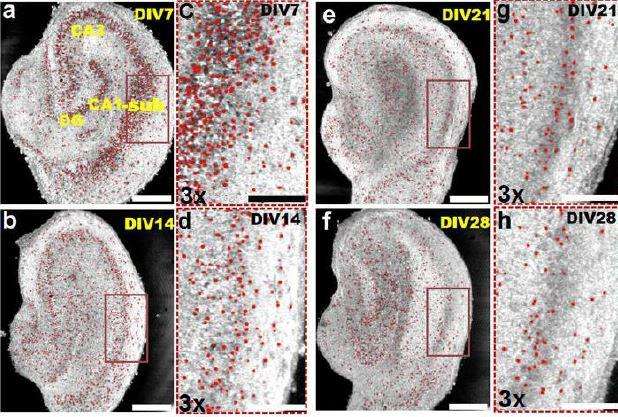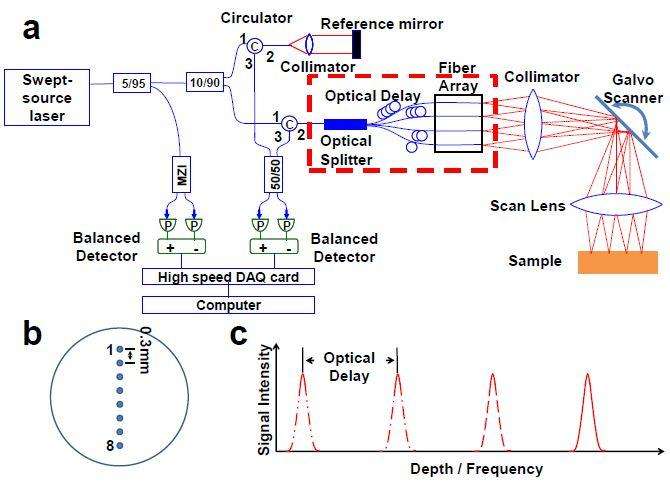Using light to map the circuitry of the brain

Scientific progress has provided a solid understanding of the anatomy of the brain. However, there is still no reliable way to examine neuron to neuron communication, as it happens—a key to understanding the correlation between brain structure and brain function.
Chao Zhou, assistant professor of bioengineering at Lehigh University, likens our current brain-mapping ability to a Global Positioning System (GPS) that can help a user locate a city, but cannot offer a street-level view. With current imaging techniques, researchers can observe layers of the brain and understand how different parts relate to each other - but they cannot examine the activity of a single neuron or network of neurons in live tissue. There is no "street-level" map of a living brain.
And yet without such a map, medicine remains in the dark about the most effective ways to treat, prevent, and cure brain disorders like Alzheimer's, schizophrenia, autism, epilepsy, and traumatic brain injury.
President Obama's BRAIN initiative aims to fast-track the search for enlightenment. Announced in 2013, the initiative supports the development and application of innovative technologies that can create a dynamic understanding of brain function with the aim of helping researchers uncover the mysteries of brain disorders.
One very important step in achieving the initiative's goals is the development of optical techniques that are sensitive enough to image at the level of single-neurons and fast enough to image live tissue.
Most neural recording techniques currently used use electrodes or require that neurons be labeled with a genetic or chemical probe in order to view neuronal action potential (the sending of electricity from one neuron to another). These methods have their downsides, according to Yevgeny Berdichevsky, assistant professor of electrical and computer engineering at Lehigh and principal investigator in the Neural Engineering Lab.
"While effective, it is not clear that electrodes are able to pick up activity in every neuron—it is also quite invasive," says Berdichevsky. "A marker introduced chemically has the potential to be toxic. It also might be too slow to pick up all the action potentials. Brain imaging cannot currently be done genetically in humans due to safety concerns."
To tackle this 21st century challenge, Zhou and Berdichevsky have joined forces to explore the use of a noninvasive, ultra-high speed biomedical imaging technology, known as space-division multiplexing optical coherence tomography (SDM-OCT). The technique could potentially map the brain using light—and does not require that neurons be labeled.
Originally developed for use in ophthalmology, optical coherence tomography (OCT) works by capturing light as it reflects off the surface of living tissue. According to Zhou, more than 30 million people world-wide per year have their eyes examined using OCT, a non-invasive test that uses light waves to take cross-section pictures of the retina.
Zhou is pioneering a key improvement to OCT that will enable a faster, more sensitive exam to detect eye diseases such as macular degeneration and glaucoma. His patent-approved diagnostic instrument uses a technology called space-division multiplexing to achieve imaging at ten times the speed of current OCT imaging.
The National Institutes of Health have awarded Zhou and Berdichevsky a grant to explore the adaptation of OCT to achieve large-scale imaging of neural activity at the single cell level—a potential game-changer in brain imaging.

When neurons fire action potentials they undergo ultra-small changes in size and shape, and OCT should be able to detect these changes as differences in the reflected light patterns. If OCT is successful in living animals, it could produce label-free and depth-resolved images of activity from thousands of neurons with micron-scale spatial resolution and sub-millisecond temporal resolution.
In other words, space-division multiplexing optical coherence tomography could provide that crucial "street-level" view of the brain researchers need to advance understanding of brain function.
"Like multiple processors"
Zhou and Berdichevsky have demonstrated the ability of OCT to provide parallel and synchronized imaging from hundreds of neurons simultaneously in a study they conducted of neuronal changes in 3-D hippocampal cultures as a result of epilepsy.
According to Berdichevsky, the technique has not been explored much as a way to detect neural activity.
"Once we were successful at using the technique to analyze epileptic tissue, we began to think about how it could be used to pick up signals from networks of neurons—something no one has done before," said Berdichevsky.
The SDM-OCT technique improves speed through parallel imaging and optical delay. To understand parallel imaging, consider how OCT is used in ophthalmology: a laser beam moves back and forth over the eye. Parallel imaging splits that single laser beam into 4, 8 or 16 beams all imaging together.
"This is a lot like using multiple processors in a computer," says Zhou. "SDM-OCT has the power of sixteen OCT machines working together, but is much less expensive than purchasing sixteen machines."
The technique also employs optical delay between imaging channels.
"This allows the image to be mapped to different frequency bands - like tuning a radio," explains Zhou. "The delay separates the images for the light to detect different optical frequencies at the same time."
Zhou and Berdichevsky plan to develop an integrated electrophysiology and ultrahigh speed SDM-OCT imaging system in order to record fast intrinsic optical signals associated with neural activity. Validation studies will be performed in vitro in 2D neural cultures and 3D organotypic brain cultures. Since each vertical cross-sectional OCT image will contain hundreds of neurons, intrinsic optical signals from thousands of neurons can be recorded simultaneously using the SDM-OCT technology.
If successful, this label-free imaging technology could become a powerful platform to investigate behavior of thousands of neurons in a network simultaneously, with the potential to significantly impact fundamental brain research.

















